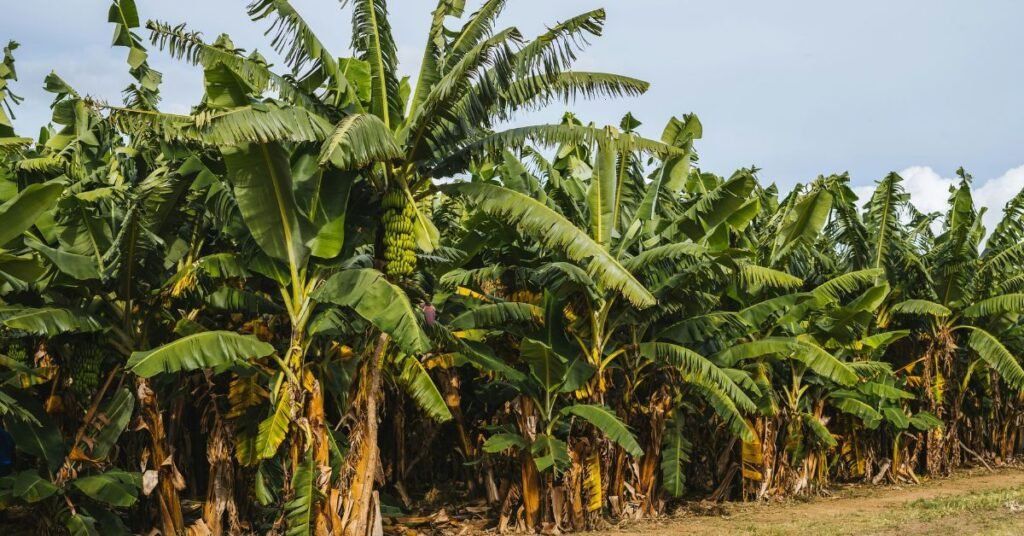The banana plant (genus Musa) is one of the world’s most widely grown tropical plants. Known for its lush green leaves and sweet, nutritious fruit, the banana plant adds beauty and purpose to any garden. While most people think of it as a tree, technically, it’s a large herbaceous plant — meaning it doesn’t have a woody stem. This article explains everything you need to know about growing and maintaining a banana plant successfully.
Overview of the Banana Plant
Banana plants are native to Southeast Asia but are now cultivated in tropical and subtropical regions around the world. They can grow between 6 to 25 feet tall, depending on the variety. The plant’s large, paddle-shaped leaves can reach up to 9 feet in length, creating a lush and tropical appearance.
Each banana plant produces a single bunch of fruit before the main stem dies, and then new shoots (called suckers or pups) grow from the base to continue the cycle.
Ideal Growing Conditions

Temperature and Climate
Banana plants thrive in warm, humid climates. The ideal temperature range is 75–95°F (24–35°C). They can’t tolerate frost, so they need protection in colder regions.
In cooler climates, gardeners often grow dwarf varieties in pots and move them indoors during winter.
Sunlight Requirements
Banana plants need 6–8 hours of full sunlight daily. Insufficient sunlight will slow their growth and reduce fruit production. When growing indoors or on patios, place them near sunny windows or under grow lights.
Soil Type
Banana plants prefer well-draining, fertile soil rich in organic matter. A slightly acidic to neutral pH (5.5–7.0) works best. Mix compost or aged manure into the soil before planting for better results.
How to Plant a Banana Plant

Choosing the Right Variety
There are several varieties to choose from depending on your needs:
- Dwarf Cavendish: Ideal for indoor or container growth.
- Grand Nain (Chiquita): Common commercial banana variety.
- Red Banana: Attractive with reddish-purple skin.
- Lady Finger: Small, sweet fruit; perfect for home gardens.
Planting Process
- Choose a sunny, sheltered spot.
- Dig a hole about 2 feet deep and wide.
- Mix compost and organic fertilizer into the soil.
- Place the banana corm (rhizome) in the hole and cover it lightly.
- Water thoroughly and mulch around the base to retain moisture.
Keep 3–5 feet spacing between plants for proper air circulation.
Watering and Fertilizing
Watering Needs
Banana plants love moisture. Keep the soil consistently moist but not soggy. Overwatering can lead to root rot, while underwatering can slow down leaf and fruit development.
Use mulch (straw or dry leaves) around the base to retain soil moisture and regulate temperature.
Fertilization
Banana plants are heavy feeders. Use a balanced fertilizer (such as 10-10-10 NPK) once every two weeks during the growing season.
For organic gardening, apply compost tea or banana peel fertilizer regularly. Increase potassium during fruiting for better yields.
Propagation of Banana Plants
Banana plants reproduce through suckers (pups) that grow at the base of the mother plant.
To propagate:
- Wait until the sucker is at least 3 feet tall.
- Carefully cut it from the mother plant using a sharp knife.
- Replant the sucker in a new pot or location with rich soil.
- Keep it well-watered until new roots establish.
This natural propagation method ensures healthy new growth and a continuous banana supply.
Pruning and Maintenance
Pruning
After fruiting, cut down the main stem to allow new shoots to grow. Remove dead or damaged leaves regularly to keep the plant clean and disease-free.
Supporting the Plant
When banana bunches develop, their weight can bend the stem. Use bamboo poles or stakes to support the plant and prevent breakage.
Common Pests and Diseases

Common Pests
- Aphids – cause curling leaves and attract ants.
- Banana weevil – damages the corm and reduces yield.
- Nematodes – attack roots and stunt growth.
Use organic pest control sprays or neem oil to protect your plant naturally.
Diseases
- Panama Disease (Fusarium wilt): Causes yellowing and wilting of leaves.
- Black Sigatoka: A fungal leaf disease that affects photosynthesis.
Rotate crops and maintain proper hygiene to avoid fungal infections.
Harvesting and Storage
Banana plants take about 9–12 months to produce fruit after planting. Harvest when the bananas are plump and slightly green.
Cut the entire bunch using a sharp knife and hang it in a cool, shaded area. The fruits will ripen naturally in a few days. For longer storage, refrigerate the ripe bananas.
Benefits of Banana Plants
Banana plants aren’t just about fruit; they have multiple benefits:
- Nutritional Value: Bananas are rich in potassium, vitamin B6, and fiber.
- Environmental Benefits: Large leaves help improve air humidity and act as natural air purifiers.
- Aesthetic Appeal: Lush green leaves give a tropical look to gardens.
- Medicinal Uses: Banana peels are used in skincare for their antioxidant properties.
Additionally, banana leaves are used as eco-friendly food wraps in many cultures.
Growing Banana Plants Indoors
If you live in a cold region, grow dwarf varieties indoors. Use a large container (at least 15 gallons), place it near a sunny window, and maintain humidity by misting the leaves regularly. Rotate the pot every few days to ensure even sunlight exposure.
Seasonal Care Tips
- Summer: Water frequently and provide fertilizer.
- Winter: Reduce watering and protect from frost.
- Rainy Season: Ensure proper drainage to prevent fungal diseases.
Consistent care ensures year-round growth and healthy fruit production.
Conclusion
The banana plant is not only an excellent fruit-bearing plant but also a symbol of tropical beauty. With the right care — including sunlight, water, and nutrients — you can enjoy fresh bananas from your own garden. Whether grown indoors or outdoors, the banana plant rewards gardeners with lush greenery and delicious fruit.

